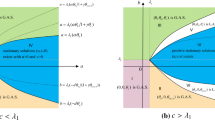Abstract
A population dynamics approach based on a system of differential equations allows us to establish conditions for the emergence of mutualism for cases such as coelenterates-algae symbionts. A central assumption of the model is that a host organism is able to discriminate, via some molecular recognition mechanisms, among different invading organisms and preferentially rejectparasites rather thanbona fide symbionts. Large differential rejection rates allow the emergence of mutualism. Different attractors of the population dynamics correspond to the emergence of mutualism, predominance of “selfish” species, or coexistence of many species.
Similar content being viewed by others
Literature
Begon, M., J. L. Harper and C. R. Townsend. 1986.Ecology. Oxford: Blackwell Scientific Publication.
Boucher, D. H., S. James and K. H. Keeler. 1982. Ecology of mutualism.A. Rev. Ecol. Systematics 13, 315–347.
De Angelis, D. L., W. M. Post and C. C. Travis. 1986. Mutualistic and competitive systems. In:Positive Feedback in Natural Systems. S. A. Levin (Ed.), p. 290 Berlin: Springer.
De Boer, R. J. 1983.GRIND: Great Integrator for Differential Equations. Bioinformatics Group, University of Utrecht, The Netherlands.
Douglas, A. E. 1988. Nutritional interactions as signals in the green hydra symbiosis. In:Cell to Cell Signals in Plant, Animal and Microbial Symbiosis. S. Scannerini, D. Smith, P. Bonfante-Fasolo and V. Gianinazzi-Pearson (Eds), pp. 283–296, Berlin: Springer.
Hohman, T. C., P. L. McNeil and L. Muscatine. 1982. Phagosome-lysosome fusion inhibited by algal symbionts ofHydra viridis.J. Cell Biol. 94, 56–63.
Ikegami, T. and K. Kanebo. 1990. Computer symbiosis—emergence of symbiotic behavior through evolution.Physica D 42, 235–243.
Lindgren, K. 1992. Evolutionary phenomena in simple dynamics. In:Artificial Life II. C. G. Langton, C. Taylor, J. D. Farmer and S. Rasmussen (Eds.), pp. 295–312. Reading, MA: Addison-Wesley.
Lis, H. and N. Sharon. 1986. Lectins as molecules and as tools.A Rev. Biochem. 55, 35–67.
McAuley, P. J. and D. C. Smith. 1982. The green hydra symbiosis. VII. Conservation of the host cell habitat by the symbiotic algae.Proc. R. Soc. London B 216, 415–426.
McNeil, P. L., T. C. Hohman and L. Muscatine. 1981. Mechanisms of nutritive endocytosis. II. The effect of charged agents on phagocytic recognition by digestive cells.J. Cell Sci. 52, 243–269.
Morse, P. and H. Feshback. 1953.Methods of Theoretical Physics. Maidenhead: McGraw-Hill.
Muscatine, L. and P. L. McNeil. 1989. Endosymbiosis inHydra and the evolution of internal defense systems.Am. Zoologist 29(2), 371–386.
Nowak, M. A. and R. M. May. 1992. Evolutionary games and spatial chaos.Nature, 826–829.
Roughgarden, J. 1975. Evolution of marine symbiosis—a simple cost-benefit model.Ecology 56, 1201–1208.
Szathmàry, E. and L. Demeter. 1987. Group selection of early replicators and the origin of life.J. theor. Biol. 128, 463–486.
Taylor, D. 1973. The cellular interactions of algal-invertebrate symbiosis.Adv. marine Biol. 11, 1–56.
Taylor, C. E., L. Muscatine and D. R. Jefferson. 1989. Maintenance and breakdown of thehydra-chlorella symbiosis: a computer model.Proc. R. Soc. London B 238, 277–289.
Weisbuch, G. 1984. Un modèle de l'évolution des espèces à trois niveaux, basé sur les propriétés globales des réseaux booléens.Comptes rendus de l'Académie des Sciences de Paris 298(III(14)) 375–378.
Wilson, D. S. 1983. The effect of population structure on the evolution of mutualism: a field test involving burying beetles and mites.Am. Naturalist 121, 851–870.
Author information
Authors and Affiliations
Rights and permissions
About this article
Cite this article
Weisbuch, G., Duchateau, G. Emergence of mutualism: Application of a differential model to endosymbiosis. Bltn Mathcal Biology 55, 1063–1090 (1993). https://doi.org/10.1007/BF02460700
Received:
Revised:
Issue Date:
DOI: https://doi.org/10.1007/BF02460700




